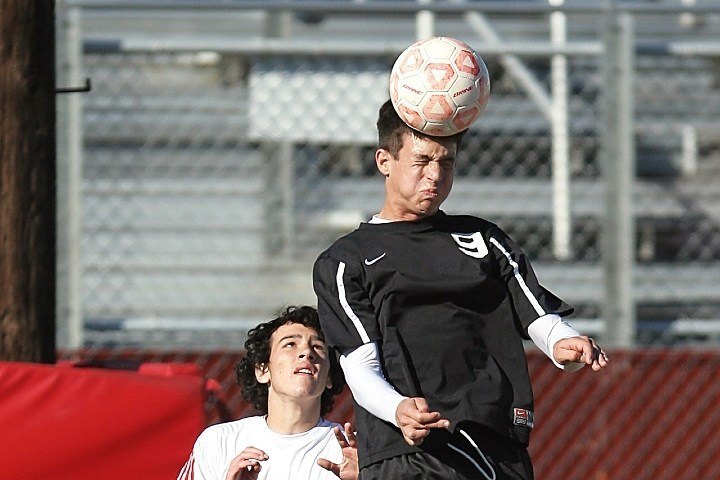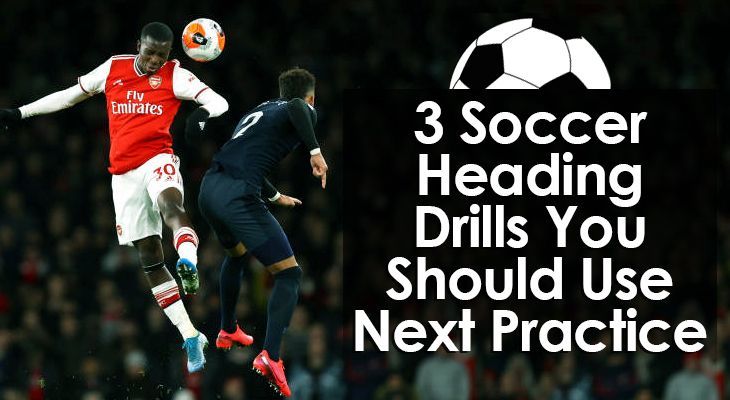5 Soccer Heading Drills (2024 Update)
Heading the ball is an essential soccer skill.
It not only helps you to score goals and defend against them, but also win the ball back and keep possession as well.
As it’s such a useful skill to have, it’s well worth using several soccer heading drills to improve this ability in your team.
By practicing different drills, your team will master the timing and technique behind heading the ball and gain confidence to challenge and compete in the air.
Before looking at some soccer heading drills for you to work through, let's first take a quick look at how to head the ball with power and precision.
But first, it’s important to note that there is an increasing body of evidence that links repeated heading of the ball to dementia later in life.
As a consequence, many soccer associations are now banning or restricting heading drills for youth players.
Please check what your local authorities recommend before trying out any of these.
Tips for Soccer Heading Technique
Being able to head the ball accurately takes a lot of practice.
You also need to be very brave, confident, and decisive in the air.
Here are some quick tips that can help you improve your timing, touch, and technique.
- Be alert and ready to anticipate the ball coming your way
- Track the flight of the ball
- Make a dummy run or feint so as to throw your opponent off guard
- Be brave and fully commit to heading the ball
- Stay on your toes, ready to sprint towards the ball
- Use your arms to hold other players off, keep your balance, cushion your fall, and increase the height and reach of your jump
- Push off your stronger foot when leaping for the ball
- Judge and time the flight of the ball so you arrive at exactly the right time
- Head the ball with your forehead
- Tense your neck muscles to cushion the blow
- Move your head towards the ball when hitting it, don't wait for it to hit you
- Follow through in the direction that you want the ball to go
- If you’re a defender you will often want to get under the ball so that you head it upwards and away from the goal
- If you’re a striker then it’s best to connect with the top half of the ball and try to aim it downwards past the keeper
By following these heading tips and practicing often, you'll soon find that your heading is much improved.
It’s also well worth watching videos of your favourite pros and teams to see how they head the ball in match situations.
Now, let's move on to some of the best soccer heading drills.

5 Soccer Heading Drills to Use Next Practice
Whether they’re trying to score a goal, defend their own box, or simply retain possession in the centre of the pitch... soccer players need to know how to head the ball in a number of different ways.
While attackers should aim to head the ball with precision and power, defenders instead need to get height and distance on the ball when heading it away from danger.
Simply controlling the ball and cushioning it downwards involves yet another skillset with the technique and touch you use differing considerably from the other types of headers.
With so many different scenarios and situations to plan and prepare for, it’s no wonder at all that mastering heading the ball takes a lot of practice.
Add in actually competing and challenging for headers against other players and, well, it gets even harder still!
To help you improve your soccer heading skills, here are some great drills for you to use in your next practice.
1. Head Through Gates
Aim:
For the players to practice heading the ball through sets of cones that are set up at different angles and distances from them.
Set up:
- The player acting as the “server” should have a number of balls at their feet, ready to throw to the players before them.
- Standing around 5 - 10 metres in front of them is a line of players. These players each get a chance to head the ball.
- Set up several goals using cones for players to aim at.
How to Run the Drill:
- When the first player calls for the ball, the server throws it up in the air for them.
- Depending on the flight, height, and speed of the ball, the player then decides which cone goal to aim for.
- While defensive headers are aimed at the back set of goals, angled attacking headers or cushioned controlled ones can be directed at the nearer sets of cones.
- Players then rotate quickly through the line, sprinting to retrieve their ball and return it to the server.
2. Run and React
Aim:
For the players to react as quickly as possible to a call, sprint into place, and head the ball into the back of the net.
Setup:
- The players who are to attack the ball line up behind a cone set about halfway between the centre circle and penalty area.
- Directly in front of that line on the edge of the box is a cone for them to run to.
- Set either side of the goal is a server who has lots of balls to throw up in the air.
- Set in front of each goal post is another cone which is placed around level with the penalty spot.
- In goal you have a goalkeeper who can practice saving headers from close range.
How to Run the Drill:
- The first attacking player runs to the cone at the edge of the box. Once they get there, one of the servers gives a shout.
- The attacking player then needs to react and sprint to their side as quickly as possible and head the ball goalwards from their throw.
- Afterwards they retrieve their ball and return it to the server while the next player has a go.
3. Crossing and Heading Game
Aim:
For attackers the aim is to get on the end of crosses and head the ball into the back of the net. For the defenders it’s to clear the ball to safety and keep a clean sheet.
Setup:
- About halfway between the centre circle and penalty area place five cones for your attacking players to stand behind.
- The two cones nearest the flanks are for your wide players who are going to cross the ball into the box and the three cones in the centre are for your strikers and centre midfielders who are going to head the ball.
- In goal you have a keeper who should command their box, communicate with their defenders, and come to claim crosses.
- Next to both posts you have two lines of defenders, waiting off the pitch, ready to enter and defend the area when the drill begins and head the ball to safety.
How to Run the Drill:
- On your whistle, one of the wide players sprints down their flank before putting in a cross for the attacking players to get on the end of.
- As they’re sprinting down the wing, the three attacking players make curved runs and feints, aiming to arrive at the right time and place to head the ball goalwards.
- While one should aim for the back post, another should make a run to the front post, with the other remaining in the middle.
- As these three players arrive in the box, the two defenders on the goalposts should sprint forward and ready themselves to head the ball away from danger.
- Once the drill has been run, the winger on the opposite flank should put in a cross with the next lot of attackers and defenders practicing their heading skills.
4. Gate Shot Heading Drill
Aim:
Players practice heading technique and accuracy by shooting between gates.
The drill is also a fun exercise that’s played at a high pace. Plus, all players play as goalkeepers, adding another entertaining element.
Set up:
Create a “goal” with agility poles or cones.
Set up two gates, five yards from either side of the goal.
Divide the team into two groups.
Each group lines up behind a gate.
One player from one of the teams starts in the goal.
The coach starts with the ball in their hands and with multiple balls by their feet.

How to Run the Drill:
The player at the front of the attacking line runs toward the goal.
The coach throws the ball toward the attacker at head height.
The attacker heads the ball on goal, trying to score between the agility poles.
The goalie can stop the ball however they like.
After the round, the attacker takes the goalie’s place, and the goalie joins the end of the opposite line.
Repeat the drill from the opposite side.
Run this drill for five to 10 minutes.
5. Run-Check-Shoot
Aim:
This drill teaches players how to make runs into the penalty box and get on the end of crosses.
Again, it also works on heading technique. More specifically, it focuses on heading while on the move.
Set up:
Use the penalty box for this drill.
Set up a full-size goal (use a goalkeeper if you have one).
Place one cone on the edge of the penalty area.
Place one cone two to three yards to the left of the penalty spot.
Place one cone on the end line, where it meets the six-yard box.
The coach stands at the cone on the end line.
The players line up on the edge of the penalty box.

How to Run the Drill:
The first player in line runs toward the cone inside the box as if they were heading to the back post.
When they reach the cone, they quickly change direction, and sprint toward the center of the six-yard box.
The coach times the run and throws a ball head-high toward the attacker.
The player makes good contact with the ball and executes an accurate and powerful header on goal.
The goalie shouldn’t try to intercept the pass but they should try to make the save.
After the shot, the next player in line performs the drill, and so on.
Run this drill for around five to 10 minutes.
Conclusion:
Well there you have it…
Three great soccer heading drills that can certainly help take you and your team's heading skills to the next level.
By working hard in training and practicing regularly, you'll soon see improvements when it comes to attacking and defending, controlling and cushioning the ball with your head.
While it certainly is a tricky soccer skill to master, with patience, practice, and perseverance, you'll be a pro at heading the ball in no time at all.
Further Reading: 123 Soccer Drills for All Ages and Skill Levels (With Images)

